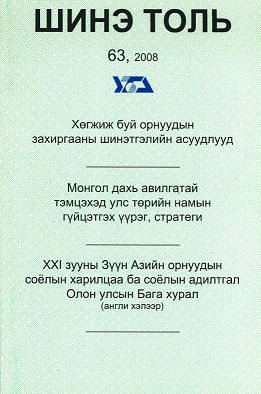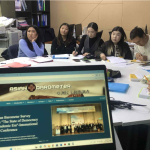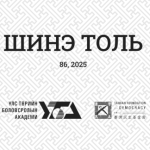![]()
Lee, Hwan Seong
Шинэ толь №63, 2008
- Introduction
Culture has become a core policy agenda of local governments as it has profoundly influenced the daily life of citizens and the whole society in the era of localization and globalization. Although making and implementing various cultural policies to improve local economy and gratify citizens’ cultural needs, however, local governments have experienced the difficulty of accomplishing the substantial policy autonomy because of the scarce human and financial resources.
In this vein, this study aims to find some solutions for improving cultural policies in local governments. Particularly, the study focuses on improving the management of culture and art organizations that local governments established. For this purpose, the study examines the case of Gyeonggi Arts Center that Gyeonggi-do, a local governmentin South Korea, has established and operated. By analyzing several problems resulted from organizational behaviors through a series of comparison between administrators and artists in the Center, the study is expected to provide some implications for cultural policies in local governments.
- Case Description: Gyeonggi Arts Center
- Organizational Purpose
Gyeonggi Arts Center (GAC) was established in 1991 pursuant to Number 3308 of the ordinances of Gyeonggi-do (The Ordinance for the Establishment and Support of GAC). Article 1 of the ordinance clarifies the organization purpose of GAC as follows: “…establish GAC to carry out the businesses for the development of culture and arts and the improvement of citizens’ cultural needs…”
- Organizational Chart
The executive board of GAC consists of 20 executives, including one president and one chief executive, and one superintendent. GAC has two broad divisions: Headquarter and Art Troupes. Headquarter consists of three subdivisions: Administration Support, Performance Project, and Korean Traditional Music Center Operation. Art Troupes comprises Theatre Troupe, Dance Troupe, Korean Traditional Music Troupe, Orchestra, and Rhythm Ensemble.
III. Analysis on Organization and Human Resource Management of Gyeonggi Arts Center
- Overview of Survey Method
We conducted a survey to examine organizational behaviors and cultures in GAC. The number of respondents was 94 among which 37 were from Headquarter and 57 from Art Troupes. The sampling of survey and the categories of questionnaires are presented respectively in <Table 3-1 > and <Table 3-2>.
<Table 3-1 > Sampling of Survey
| Division | Headquarter | Art troupes | ||||
| Subdivision | AdministrationSupport | PerformanceProject | KoreanTraditionalMusicCenter Operation | TheatreTroupe | TraditionalMusicTroupe | Orchestra |
| No of Sample | 10 | 23 | 4 | 5 | 43 | 9 |
- Attitude to Organization and Job
1) Job Satisfaction
Job satisfaction of organizational members was measured with 14 items, such as satisfaction with organizational life, salary, promotion, job security, welfare, relationship, etc. The overall level of job satisfaction was a little higher (4.2) than the average level (4.0). The members
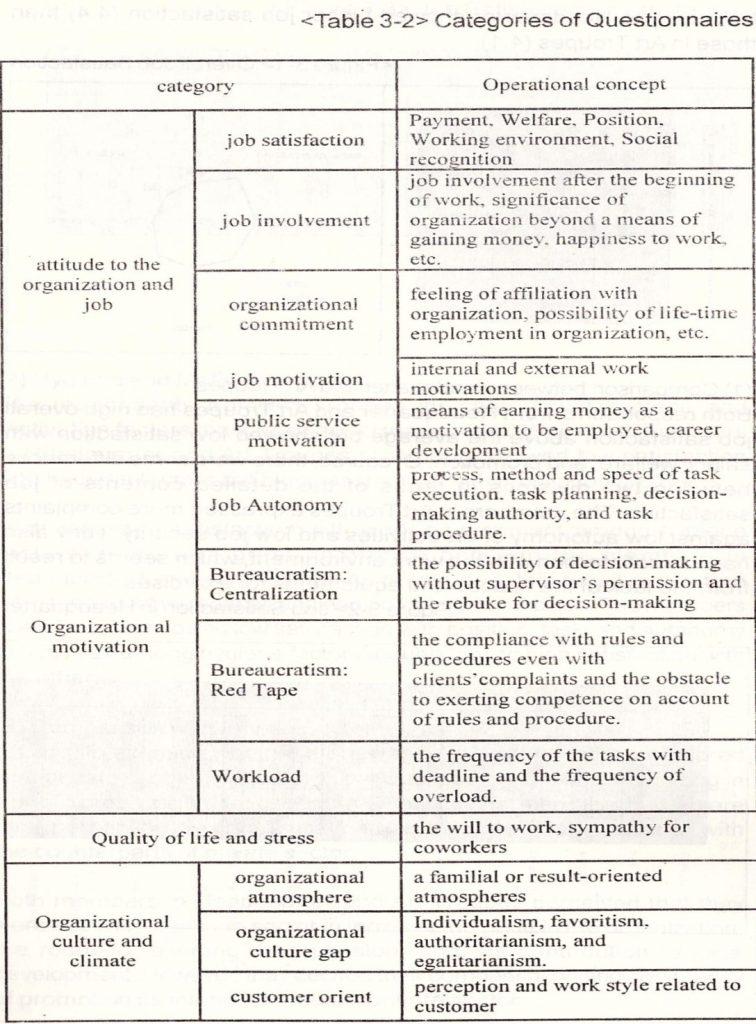
belonging to Headquarter showed higher job satisfaction (4.4) than those in Art Troupes (4.1).
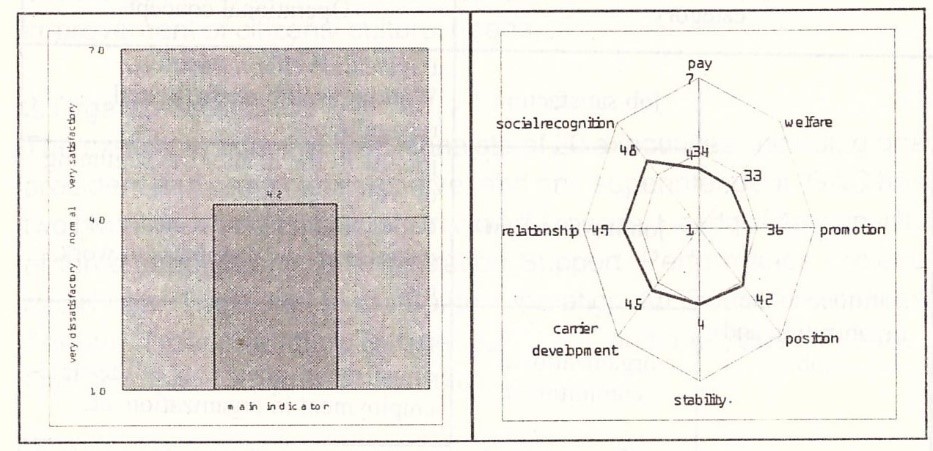
- Comparison between Headquarter and Art Troupes Both respondents from Headquarter and Art Troupes had high overall job satisfaction above the average but showed low satisfaction with salary, welfare, and promotion. Of course, there were some differences between two divisions in terms of the detailed contents of job satisfaction. The members in Art Troupes expressed more complaints against low autonomy of art activities and low job security. They also had low satisfaction with the work environment, which seems to result from the lack of the spaces and equipments for exercises.
<Figure 3-2> Job Satisfaction in Headquarter
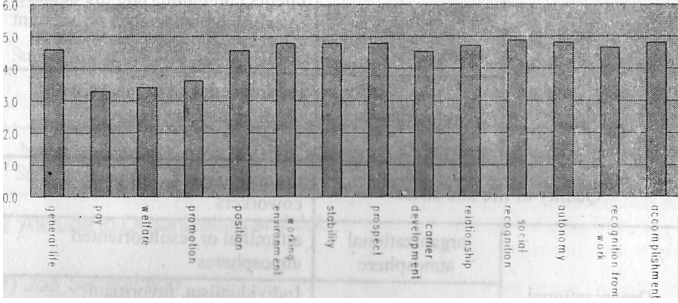
- Hygiene and Motivation Factors
The respondents from Art Troupes indicated lower hygiene and motivation factors than those from Headquarter. While both members in Headquarter and Art Troupes commonly showed low satisfaction with hygiene factors but high satisfaction with motivation factors.
With regard to satisfaction with work environment among hygiene factors, there was great difference between the members in Headquarters and Art Troupes. As mentioned, this result may come from the lack of the spaces and equipments for exercises. The members in Art Troupes showed low satisfaction with position, task, and autonomy of activities among hygiene factors though having high satisfaction with the others.
- Comparison with Private Sector
In order to examine whether there was relative deprivation compared with private sector or whether there was a sense of pride in working in a public organization, we asked the organizational members to compare their perception on compensation, job security, work-load, etc. with the counterparts of private sector.
Both members in Headquarter and Art Troupes perceived that they were superior to private sector in terms of the pride in the organization, the room for exerting their passion, and the contribution to local development. However, they decried their compensation and opportunity of promotion as inferior to those in private sector.
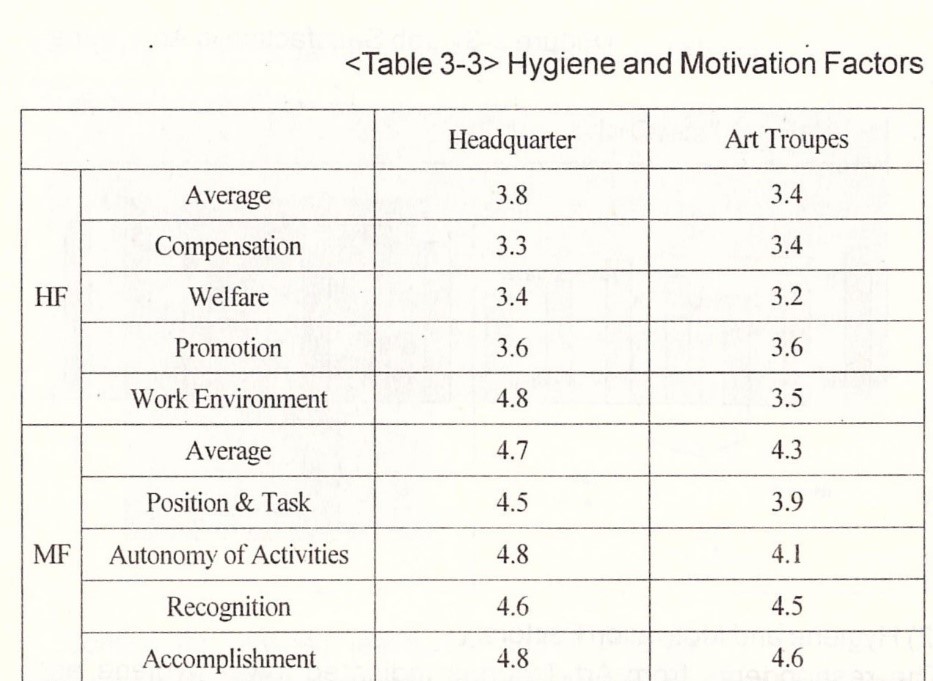
- Hygiene and Motivation Factors
The respondents from Art Troupes indicated lower hygiene and motivation factors than those from Headquarter. While both members in Headquarter and Art Troupes commonly showed low satisfaction with hygiene factors but high satisfaction with motivation factors.
With regard to satisfaction with work environment among hygiene factors, there was great difference between the members in Headquarters and Art Troupes. As mentioned, this result may come from the lack of the spaces and equipments for exercises. The members in Art Troupes showed low satisfaction with position, task, and autonomy of activities among hygiene factors though having high satisfaction with the others.
- Comparison with Private Sector
In order to examine whether there was relative deprivation compared with private sector or whether there was a sense of pride in working in a public organization, we asked the organizational members to compare their perception on compensation, job security, work-load, etc. with the counterparts of private sector.
Both members in Headquarter and Art Troupes perceived that they were superior to private sector in terms of the pride in the organization, the room for exerting their passion, and the contribution to local development. However, they decried their compensation and opportunity of promotion as inferior to those in private sector.
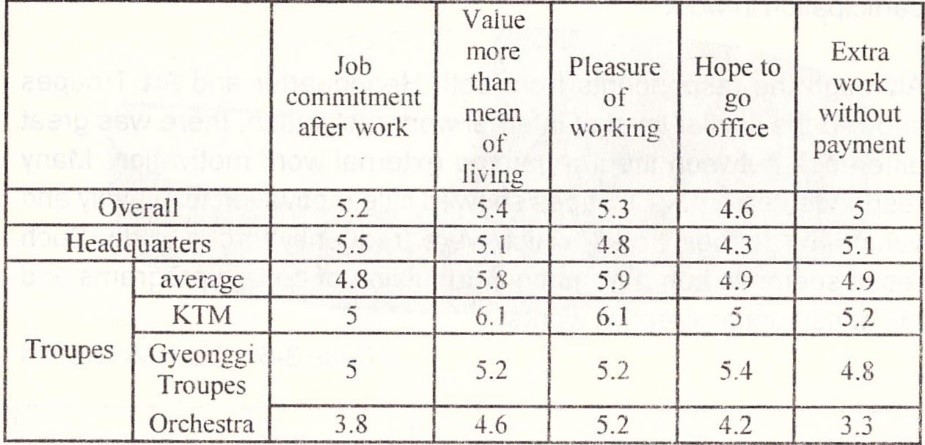
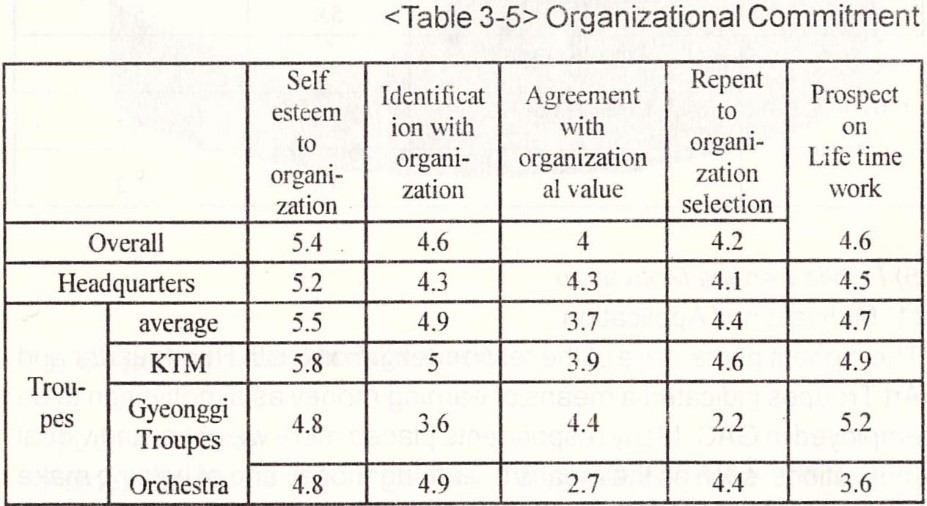
- Work Motivation
We examined internal and external work motivations. Internal work motivation was measured with three items: whether the respondent is interested in work, feels happy when working, and has the feeling of accomplishment. External work motivation was measured by three items: whether the work is compulsory, voluntary, and for success.
The overall work motivation was above the average. Particularly, the respondents showed high internal work motivation. High internal work motivation can be advantageous to organizations because it leads to high enthusiasm for work and accomplishment as well as voluntary participation in work.
Although the respondents from both Headquarter and Art Troupes showed the similar level of internal work motivation, there was great difference between them regarding external work motivation. Many respondents from Art Troupes showed little motivation to actively and voluntarily do their works, which were frequently forced to do. Such result seems to come from the compulsion of certain programs and the constraint on creative works.
<Table 3-6> Work Motivation
| Headquarters | Troupes | ||
| Internal | Interest in work | 5.2 | 4.9 |
| Pleasure in work | 5.1 | 5.2 | |
| Accomplishment | 5.0 | 5.5 | |
| External work motivations | Compulsory work | 4.1 | 4.9 |
| Delegated work | 4.2 | 5.5 | |
| Need to succeed | 4.8 | 5.2 | |
5) Public Service Motivation
- Motivation of Application
The highest percentage of the respondents from both Headquarter and Art Troupes indicated a means of earning money as a motivation to be employed in GAC. Many respondents placed more weight on individual motivations, such as the means of earning money and of helping make a career, than on public motivations, such as the means of helping local economic development.
- Achievement Goals
As achievement goals, the highest percentage of the respondents gave greater weight on the goals of individual achievement, such as the accumulation of skills and job security. Particularly, the respondents from Art Troupes had higher priority to job security than those from Headquarter. This result may represent the fact that the respondents from Art Troupes put more emphasis on securing their job because of lower job security in their division.
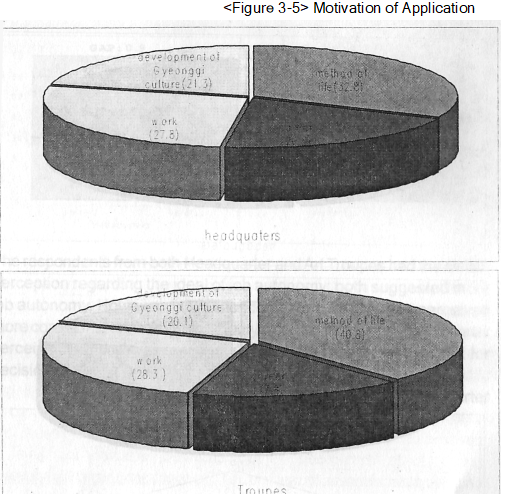
- Organizational Management
1) Job Autonomy
Perception on job autonomy was measured with six items: process, method and speed of task execution, task planning, decision-making authority, and task procedure. The gap between the ideal and the real of job autonomy was highly wide (1.6) as presented in <Figure 3-7>.
The gap between the ideal and the real of job autonomy perceived by the respondents from Headquarter (0.9) was narrower than the gap perceived by the respondents from Art Troupes (2.4).
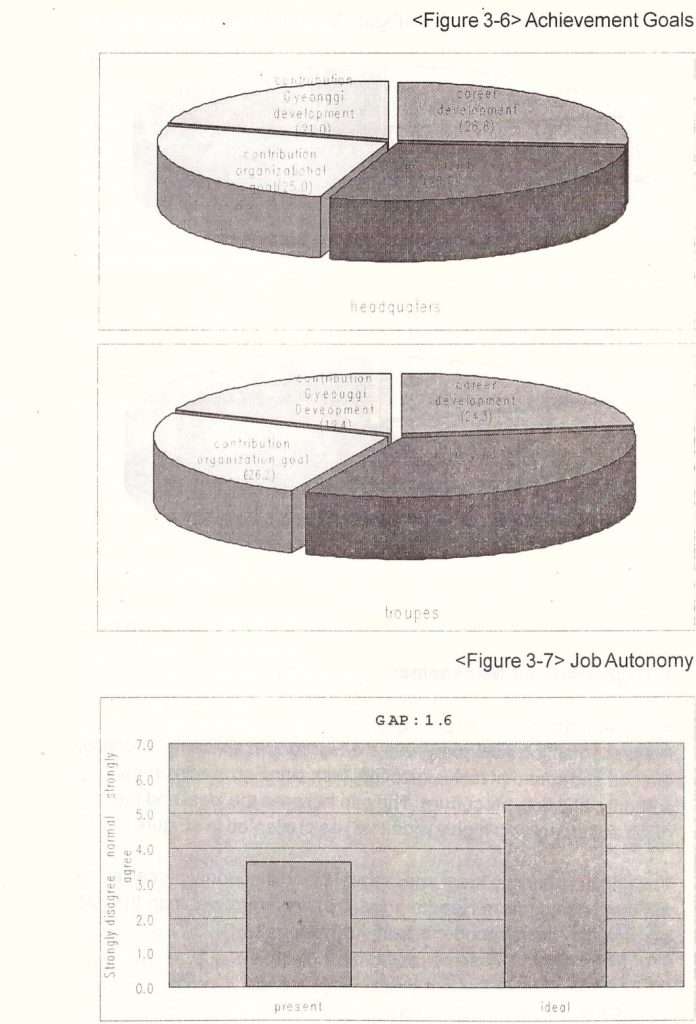
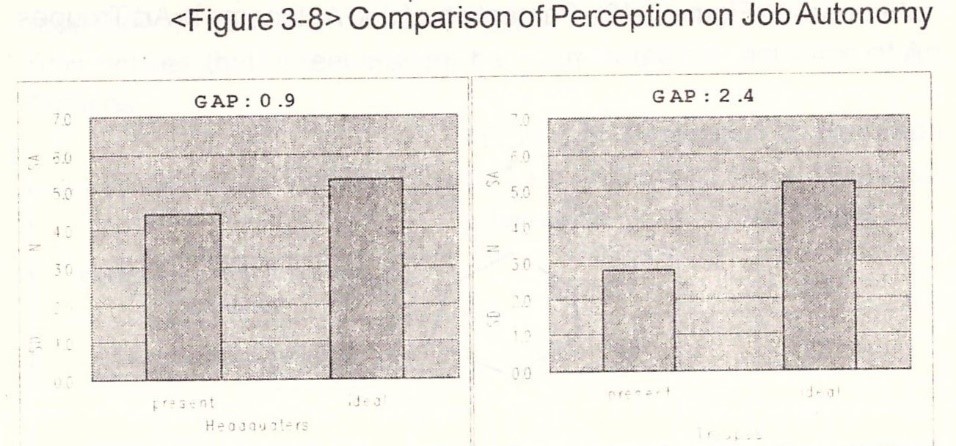
The respondents from both Headquarter and Art Troupes had the similar perception regarding the ideal of job autonomy; both suggested more job autonomy. However, the respondents from Art Troupes perceived more constraints on their job autonomy whereas those from Headquarter perceived that their job autonomy was above the average except for decision-making authority.
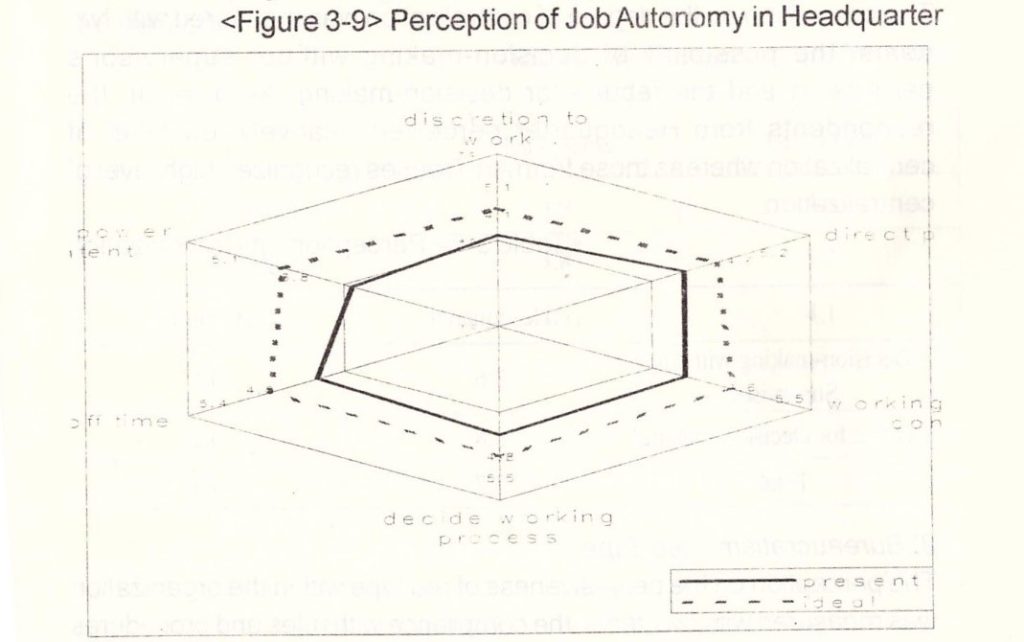
In contrast to those from Headquarter, the respondents from Art Troupes recognized that their job autonomy was very low in every aspect. They insisted much higher level of job autonomy than at present.
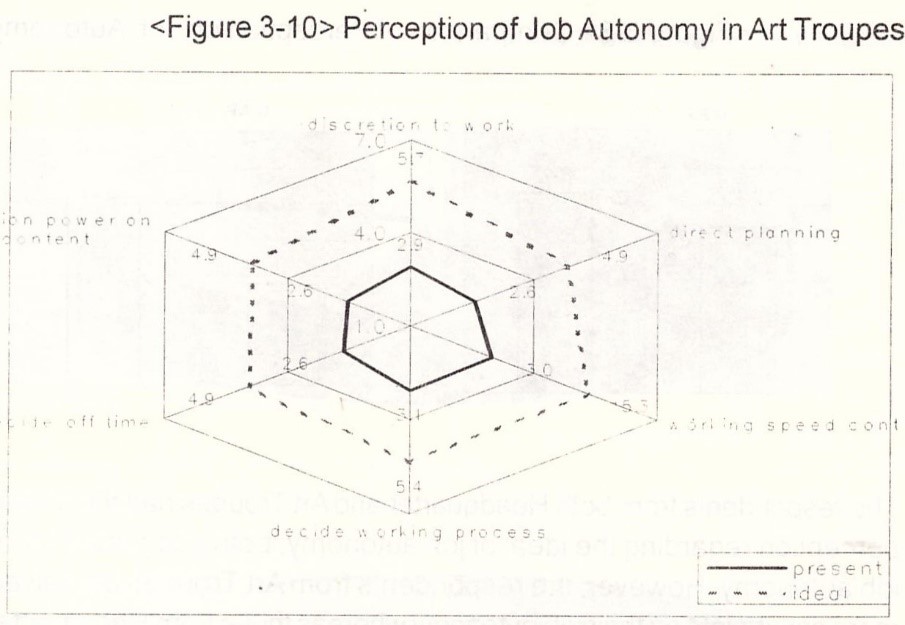
- Bureaucratism: Centralization
The perception on the degree of centralization was measured with two items: the possibility of decision-making without supervisor’s permission and the rebuke for decision-making. As a result, the respondents from Headquarter perceived relatively low level of centralization whereas those from Art Troupes recognized high level of centralization.
<Table 3-7> Perception on Centralization
| Headquarter | Art Troupes | |
| Decision-making without Supervisor | 3.6 | 4.6 |
| Rebuke for Decision-making | 3.8 | 4.2 |
| Total | 3.7 | 4.4 |
- Bureaucratism: Red Tape
The perception on the pervasiveness of red tape within the organization was measured with two items: the compliance with rules and procedures even with clients’ complaints and the obstacle to exerting competence on account of rules and procedure. The respondents from Art Troupes perceived higher level of red tape than those from Headquarter. Particularly, the percentage of the respondents who adhered to rules and procedures without regard to clients was higher among the respondents from Art Troupes than among those from Headquarter. This implies that bureaucratism had dominated the activities of Art Troupes.
<Table 3-8> Perception on Red Tape
| Headquarter | Art Troupes | |
| Compliance with Rules and Procedures | 3.6 | 4.6 |
| Obstacle to Competence | 3.8 | 4.2 |
| Total | 3.7 | 4.4 |
- Workload
The perception on the appropriateness of workload was measured with two items: the frequency of the tasks with deadline and the frequency of overload. More respondents answered that they experienced overload. Particularly, the organizational characteristic that follows the exact timetable of performances appears to make the organizational members burdensome.
<Table 3-9> Perception on Workload
| Headquarter | Art Troupes | |
| Deadline | 4.9 | 4.4 |
| Overload | 3.8 | 3.7 |
| Total | 4.4 | 4.1 |


